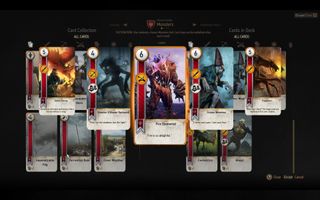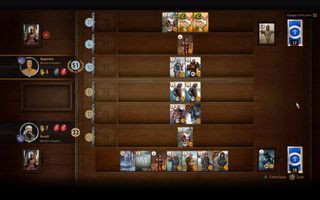The making of Gwent

Some abilities proved too complicated for inclusion. “We had some monsters that could piggyback onto other cards and gain their ability,” says Monnier by way of example. “So you would piggyback your cards on heroes to become immune. That didn’t last long because it looked bad on the board, and clashed with the horizontal look of the game. Even explaining it sounds confusing.”
Once the cards were in place, CD Projekt RED had to seed them throughout the game. Gwent is played throughout the Continent—each act of the campaign has a number of traders and innkeepers who sell cards, and a series of special opponents who can be challenged for some of the most valuable cards in the game. “We really wanted Gwent to follow the same overall feel of the rest of the game,” says Slama. “Keeping with that, we spread out the cards appropriately and made no real effort to stop players from getting any particular card at a specific time.”
The exception to that was the Hero cards—unique, powerful cards that take the form of some of the story’s most recognisable characters, including Triss, Yennifer and Geralt himself. “These were meant to be rare and we used them as an incentive to play against the wonderful cast found within The Witcher universe. After all, who’d want to win a two-power ghoul after defeating Dijkstra at a game of wits?”
A more serious Gwent player would have access to the more rare and powerful cards, the equivalent of a master crafter sword.
Part of ensuring Gwent paralleled the progression of the rest of the game was creating a natural difficulty flow across the critical path. Rounds can be played against numerous NPCs throughout the game, but each section also has sidequests directing the player to the region’s most renowned Gwent masters. As you might expect, balancing Gwent’s difficulty meant tuning the deck strength of each opponent. “We worked really hard to have the AI know how to take advantage of special cards to gain an edge,” says Slama, “and, as a result, giving the AI decks more of those cards just naturally made them more challenging to play against.”
Slama makes a comparison to that most recognisable of RPG concepts, a character’s inventory. “A lower level player would use a deck with less powerful cards, which can be equated to him or her using an old rusty sword. Meanwhile, a more serious Gwent player—notice how their dialogue would include some form of boasting about how good their decks were—would have access to the more rare and powerful cards, the equivalent of a master crafter sword.”

Not that tuning the difficulty was easy, particularly because—as in many games with asymmetrical factions—people became convinced that one was overpowered. “Our QA warriors are on it all the time, each with their own favourite deck and faction, and each with their own request. I wish I had a złoty for every bug that starts with, ‘This faction is OP!! I keep getting spanked please fix it,’ while the same opponent would be seen as too easy by others. It’s a tricky thing to balance.”
Tweaking the AI proved to be another big challenge, and the Gwent team went through multiple iterations. At the same time, the early prototypes became a useful way for the team to learn advanced tactics. “The first [AI] version would simulate all the possible moves and try to predict which gave the best result,” says Slama. “One of the ways we would allow difficulty to change during this iteration was to set how many moves ahead it could simulate. During this time period, the AI would occasionally surprise us with combinations, like dummying its highest value card so it could scorch a whole row of our cards the next turn. It actually taught us a lot about combos.”
PC Gamer Newsletter
Sign up to get the best content of the week, and great gaming deals, as picked by the editors.
The problem with those early AI versions wasn’t tactical ability, but something much more human. “It was a challenge for us because Gwent is more about managing your hand and also bluffing,” says Monnier, “so the AI had to take that into account. It was really hard to debug and see why the AI played a certain card over another—whether or not this was a valid move, and not something you wouldn’t personally do.”
Clearly Gwent became a hit, and one of the most celebrated parts of a critically acclaimed game. In recognition of this, the Gwent team reunited to add more cards for the first expansion, Hearts of Stone. Later this year, CD Projekt RED will release The Witcher 3’s second and final expansion, Blood and Wine. Will Gwent return with it? “To tell you the truth, Jason, Rafał and I never expected the game to be so popular,” admits Monnier. “Since our next expansion is the last one, we really want to end with a bang. You’ll have to wait and see.”

Phil has been writing for PC Gamer for nearly a decade, starting out as a freelance writer covering everything from free games to MMOs. He eventually joined full-time as a news writer, before moving to the magazine to review immersive sims, RPGs and Hitman games. Now he leads PC Gamer's UK team, but still sometimes finds the time to write about his ongoing obsessions with Destiny 2, GTA Online and Apex Legends. When he's not levelling up battle passes, he's checking out the latest tactics game or dipping back into Guild Wars 2. He's largely responsible for the whole Tub Geralt thing, but still isn't sorry.

Witcher remake studio boss says it'll remake what's 'bad, outdated, or unnecessarily convoluted' without naming the sex baseball cards we all know he's talking about

A new Witcher comic series spoils Geralt's retirement with a Western-styled 'homage to Andrzej Sapkowski, Clint Eastwood, and Sergio Leone'
Most Popular







